Forum Replies Created
-
AuthorPosts
-
 Robin LeadbeaterParticipant
Robin LeadbeaterParticipantThe same would apply if using the G channel from a DSLR to estimate the V mag of the nova as the G channel response at H alpha is different again eg
http://www.astrosurf.com/buil/50d/test.htm
Robin
 Robin LeadbeaterParticipant
Robin LeadbeaterParticipantI remember Gordon Myers talking about transformations (and extinction) at the 2018 BAA/AAVSO joint meeting.
https://britastro.org/video/13862/14771
He put some numbers to the size of the effect for different systems he tested (6:39)
At the end of the day though these are still approximations dependent on the actual spectrum and can be way out in some circumstances. As an extreme (though real) example, a Nova spectrum dominated by H alpha. eg
https://britastro.org/specdb/data_graph.php?obs_id=650
A significant fraction of the H alpha flux would appear in the standard Johnson-Cousins V passband but would be completely missed by the Chroma version. Spectroscopy is much more straightforward 😉
Robin
 Robin LeadbeaterParticipant
Robin LeadbeaterParticipantHi Andrew,
I thought Bessell was pretty much the same as Johnson-Cousins eg here half way down the page
http://spiff.rit.edu/classes/phys440/lectures/filters/filters.html
Of course the elephant in the room is the response of the sensor which is very different today compared with detectors of previous eras
Robin
 Robin LeadbeaterParticipant
Robin LeadbeaterParticipantThe response curve of those Chroma filters
https://www.chroma.com/products/sets/27103-bessell-ubvri
looks very different from the Baader (and other) versions I’ve seen
http://astrograph.net/Baader-Planetarium-Johnson-/-Bessel-V-Filter-125-and-50mm-x-50mm
Robin
 Robin LeadbeaterParticipant
Robin LeadbeaterParticipantChristian Buil has an interesting CCD/CMOS comparison. Though specifically concentrating on spectroscopy,he covers camera noise, amp glow and linearity
http://www.astrosurf.com/buil/CMOSvsCCD/index.html
With high resolution spectroscopy of faint objects at the limit of detectability the sky signal is insignificant so camera noise becomes the most significant source of noise. To minimise read noise contribution, exposure lengths used with CCD are typically >1200sec and it takes many hours to get a sufficiently noise free stack of darks, though cloudy nights can be used of course!
Although low, the read noise in CMOS is not insignificant and once the typical slit width relative to pixel size is considered, is not that different from that of good CCD because of the ability to bin pixels with CCD so there is not much latitude for combining shorter exposures with CMOS (though an spectrograph optimised specifically for the small pixels found in common CMOS sensors could perhaps avoid this). The thermal noise is also typically higher for CMOS cameras which need much lower temperatures to match that of a CCD so although the performance gap is not large these days, CCD still appears to have the edge in performance (Though not in cost per area) when used with currently available commercial spectrographs.
Cheers
Robin
 Robin LeadbeaterParticipant
Robin LeadbeaterParticipantWith the help of Thomas Bayes perhaps I can now claim to have previously detected both the Balmer H beta absorption with emission core and H alpha emission 😉
My rectified spectrum from 2020-05-30 (red) overlaid on the spectrum published in the Atel
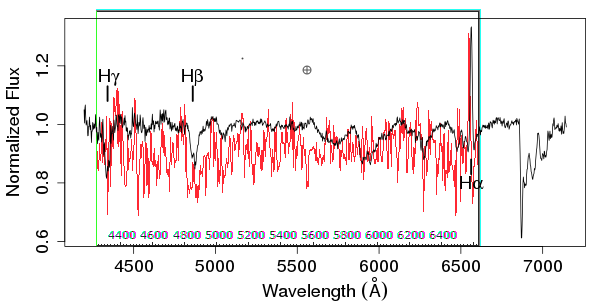
(I also see the problem of not being able to insert images. I had to press “preview” before I got the “insert” option)
Robin
 Robin LeadbeaterParticipant
Robin LeadbeaterParticipantOK here are the spectra for 2020-05-29 and 30.
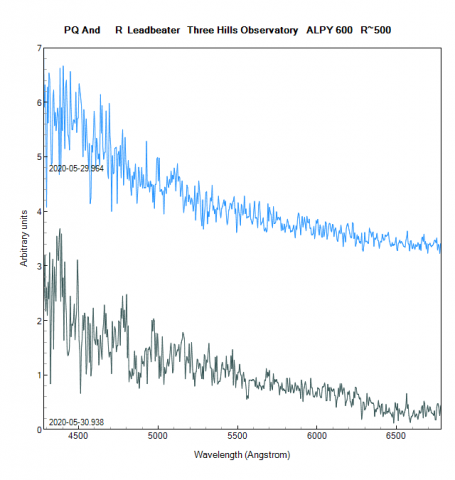
Apart from the hot continuum there is nothing common between them so unfortunately the details are probably just noise. They were taken at 5 deg altitude (air mass 10) in a bright sky though so to be honest it was a surprise to get anything
 Robin LeadbeaterParticipant
Robin LeadbeaterParticipantHi Jeremy
Should supernova spectroscopic observations be reported independent of their inclusion in the database? (SN 2020ue mentioned has 22 spectra and SN 2020hvf has 5 in the database currently and there are recent spectra of 4 other supernovae)
Cheers
Robin
 Robin LeadbeaterParticipant
Robin LeadbeaterParticipantAnd the spectrum against the bright sunlight, strong telluric lines and auroral and atmospheric sodium emission lines.

Note how the spectrum curves down towards the blue end due to the strong atmospheric refraction. Not sure if I can extract much of use from it but it was fun trying !
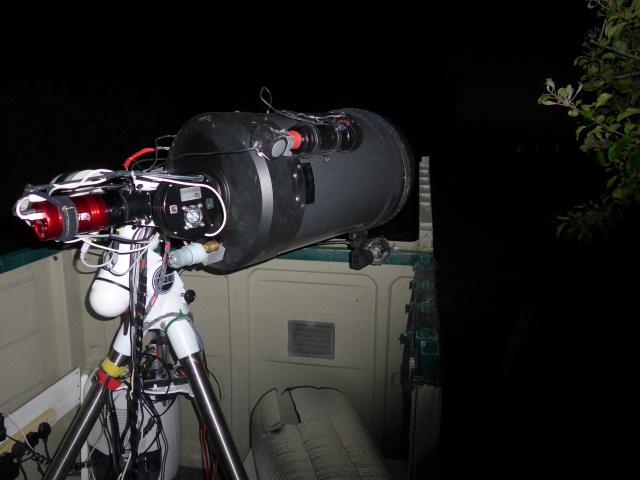
 Robin LeadbeaterParticipant
Robin LeadbeaterParticipantHere it is in the spectrograph guider a few minutes ago (at 5 deg altitude !)
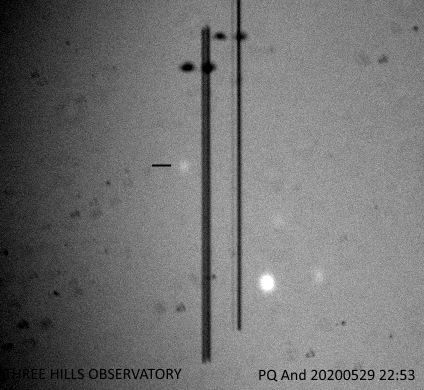
 Robin LeadbeaterParticipant
Robin LeadbeaterParticipantA tough one. I’ve put out an alert on the main spectroscopy forums. It is (just) circumpolar for me and I although I do have a decent (though currently bright) horizon directly north, I lose it behind a tree as it climbs in the dawn sky
 Robin LeadbeaterParticipant
Robin LeadbeaterParticipantHi Graeme,
You definitely need to set up an annulus of some width to measure and subtract the background. If not, as Andy says you include light from the galaxy (and light pollution etc) with the supernova in the brightness measurement. Too narrow though and the background level measurement becomes noisy. To wide (or too far out) and it becomes unrepresentative of the background where the target is. Perhaps you could try annuluses (annuli?) of different non zero widths and see how much the result varies ?
 Robin LeadbeaterParticipant
Robin LeadbeaterParticipantYes the sky background has to be subtracted somehow. The same problem crops up in spectroscopy of supernovae and some programs have various ways of fitting a model to the sky background in the surrounding region. In my limited experience of photometry I think programs which model the star point spread function against the background work better in this situation, though there could still be a bright/or dark patch directly under the target of course. The transient survey instruments get round this problem by subtracting an image taken when the transient was not there.
Robin
 Robin LeadbeaterParticipant
Robin LeadbeaterParticipantThis is an interesting one. It was discovered very early back on 21st April and is just hitting maximum light now. I took a spectrum on 27th April but could not then get a good match using the SNID classification software I usually use, possibly because it does not have many early spectra to compare with. Current spectra give a good match to type Ia now though and the brightness is bang on where it should be for a type Ia. Here is my spectrum (also in the BAA database as usual) and there is a more current spectrum here on the ARAS forum
http://www.spectro-aras.com/forum/viewtopic.php?f=38&t=2519
Cheers
Robin
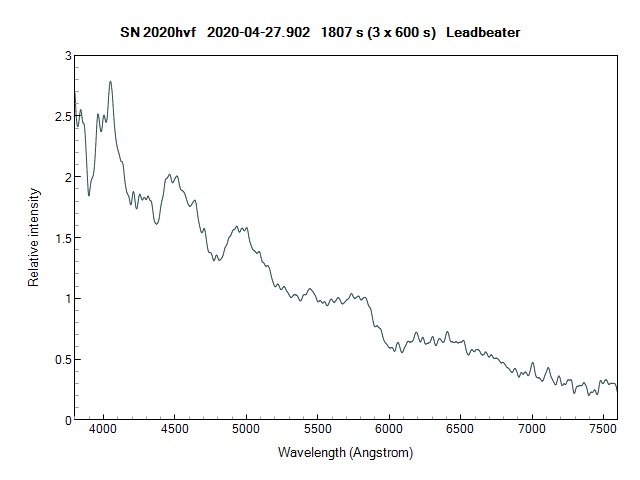
 Robin LeadbeaterParticipant
Robin LeadbeaterParticipantHow about a proper PCI board parallel port if you can fit one? They seem to still be available for 64 bit and up to win 10 eg
https://www.startech.com/uk/Cards-Adapters/Parallel/1-Port-EPP-ECP-PCI-Express-Parallel-Card-~PEX1P
Robin
 Robin LeadbeaterParticipant
Robin LeadbeaterParticipantThat is my simple small dish setup using currently used sat TV frequencies. I think the big ones used lower frequencies (C band ?) and I believe are good for making Hydrogen line receivers if you can find one (more popular in the US I think)
 Robin LeadbeaterParticipant
Robin LeadbeaterParticipantHi Kate,
Spectral classification is a rather inexact science as many stars show anomalies which don’t fit neatly into the simple MK classification system. As a result you get different opinions for the classification even for non variable stars (Variable stars can change their classification with time for example due to temperature changes caused by pulsations)
A good source for spectral classifications is Brian Skiff’s huge catalogue which has all the published classifications with the references for currently approaching a million stars
http://vizier.u-strasbg.fr/viz-bin/VizieR?-source=B/mk
Here we see for sigma Boo a range of classifications dating from 1897 to 2001
F4V kF2 mF1 is the latest one and comes from a paper by Richard Gray who is famous in stellar classification circles and for example co-authored the current “bible” on the subject “Stellar Spectral Classification” by Gray and Corbally
The paper referenced is here
http://simbad.u-strasbg.fr/simbad/sim-ref?bibcode=2001AJ….121.2148G
There he notes that sigma Boo is metal weak and looking in the footnotes to table I (page 2155) he explains the multiple classification nomenclature he has used. So for sigma Boo we have a metal weak star with the traditional classification F4V, presumably based on the Balmer lines but based on the strength of the Ca II K lines it looks like an F2 and based on the metal line spectrum it looks like an F1
Robin
 Robin LeadbeaterParticipant
Robin LeadbeaterParticipantUnless otherwise explicitly stated I always assume events organised by humans are in the organiser’s local time. It has not let me down yet 😉
In this case however the browser is changing the time shown on the website to the readers local time which in my view cannot be a good idea.
 Robin LeadbeaterParticipant
Robin LeadbeaterParticipantA big welcome to all Reality Titbit readers from all at the British Astronomical Association 🙂
13 April 2020 at 6:55 pm in reply to: Forum “Last Post” button and new posts getting lost up the thread #582279 Robin LeadbeaterParticipant
Robin LeadbeaterParticipantHugh Allen posted yesterday showing its continuing spectroscopic evolution on the way back to “normal” in reply to an earlier post of mine
-
AuthorPosts
